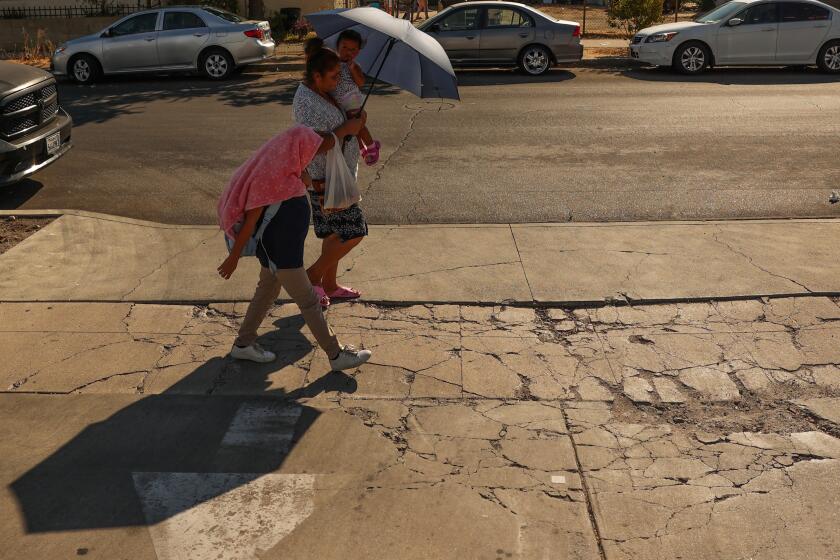Neighbors divided
In the nearly four years since former President Clinton signed the Religious Land Use and Institutionalized Persons Act, intended to ease city zoning restrictions for religious institutions, the civil rights law has pitted neighbor versus neighbor and church versus state in areas nationwide.
About 50 cases in such states as California, Florida, Texas, Hawaii and Alabama are challenging the federal law as residents worry that churches, temples, mosques, homeless shelters and other religiously affiliated institutions will erode the quality of life in neighborhoods and business areas. At the same time, cities are finding the law has undermined their right to zone their own communities.
“This means a lack of control over land use,” said Los Angeles Asst. City Atty. Cecilia V. Estolano. “A municipality needs to be able to control its own borders ... its own destiny.”
Under the law, a religious institution can operate “a casino, a liquor store or any farfetched adventure,” Estolano said. “Any form of denial for use can become an RLUIPA issue.”
Religious groups that have invoked the law for protection say they are only fighting for the right to practice their faith and serve in areas where they feel they are needed.
The congressional record states the law was needed because there has been “massive evidence” of discrimination nationwide because of race, especially of black churches, or religion, especially Jewish synagogues. Additionally, the record noted, discrimination has occurred because religious institutions generate too much traffic in residential areas or not enough in commercial zones or may be aesthetically inconsistent with city planning. Those opposed to RLUIPA dispute these claims.
California, which often leads the nation in real estate trends and issues, appears at the forefront of testing the law. Of the cases wending their way through courts nationwide, about a third are in California, according to Roman Storzer, an attorney with the Washington, D.C.-based Becket Fund for Religious Liberty.
“There is such greater emphasis on land in California,” Storzer said. “You don’t see these kinds of cases in North Dakota. Most of the time this is about neighbors’ NIMBYism and churches’ abilities to worship.”
Some homeowners claim to have concerns about quality-of-life issues -- increased traffic, for instance -- and others worry that property values will suffer.
But, according to John Karevoll, an analyst with La Jolla-based DataQuick Information Systems, the presence of religious institutions in neighborhoods does not affect home prices.
“The only effect on home values are really those that are economic,” he said, adding that only a loss of jobs or increased crime in an area have proved to negatively affect prices.
“We’ve even looked at what happens when, for instance, a halfway house comes into a neighborhood, and we’ve found there are no discernible effects on home values,” Karevoll said. “For every home buyer bothered by something, there are 10 other buyers out there willing to disregard the issue.”
For Hancock Park resident Michelle Younis, the construction of an 8,000-square-foot Orthodox Jewish temple for the Etz Chaim congregation next to her home at the corner of 3rd Street and Highland Avenue is an issue of loss of privacy.
“I like to sunbathe,” said Younis, 35. “I can’t do that anymore. In fact, I can’t even change in my bedroom without drawing the shades as the windows of the temple overlook my room.”
Younis was particularly troubled by what appeared to be security surveillance cameras that were installed outside the building during construction. “I can no longer do anything in my backyard” because of a camera that seems to point directly at the yard, she said. The temple said the camera monitors a walkway on its property.
For other neighbors, some of whom have long argued that the congregation should not be allowed to hold services in a neighborhood zoned for single-family homes, it’s a quality-of-life issue. Nine Hancock Park homeowners have filed a lawsuit against the city of Los Angeles challenging RLUIPA and for allowing a single-family residence to be remodeled into a full-scale temple in their neighborhood.
The homeowners want the original structure -- a 3,600-square-foot two-story house that the congregation had been using for services since the 1990s -- to be restored. The house fell down in 2002 during a city-approved major remodel.
The litigants worry that their community will be eroded by nonresidential uses, that institutional buildings will increase traffic, and that the remodel is overbuilt for the lot.
“This is about how the city gave up our residential zoning, and we are afraid the temple will create a precedent” for other nonresidential uses, said neighboring homeowner Cindy Chvatal-Keane, a litigant in the case. “This isn’t about religion. This could be a church or a mosque, a temple or a parking lot, it wouldn’t matter.”
But according to congregation member Gary Apfel, 51, the issue is one of religious freedom. To Apfel and about 40 others associated with the temple, the attempt of homeowners to shut them down, he said, is a furtherance of the persecution and discrimination Jews have felt since the Holocaust.
“We have an obligation to stand up for people who could not stand up for themselves,” said Apfel, an attorney who works in downtown Los Angeles. “We have the obligation to not allow any form of discrimination. Are we overly sensitive? You bet we are.... Thank God we have a federal government who protects minorities.”
Since 1997, the city of Los Angeles had repeatedly denied Etz Chaim’s requests for a conditional-use permit and a variance to use the house as a temple. But when the act became law, it gave the congregation new hope for being able to hold services there. For decades before the dispute about the house at 3rd Street and Highland Avenue, the congregation had conducted services in another house three blocks away.
“RLUIPA saved the day for the congregation,” said Susan Azad, an attorney with Latham & Watkins downtown who is handling legal matters pro bono for the temple. “The homeowners just don’t want the congregation there.”
The city of Los Angeles, under then-City Atty. James Hahn, settled with the congregation in the fall of 2001, and Etz Chaim was given the go-ahead to conduct services at the site. According to city officials, the specter of RLUIPA loomed large over the decision at the time.
Later, the city building and safety department approved the congregation’s plans for a major remodel that, according to city officials, should never have been approved, as the plans did not meet with terms of the settlement agreement. After the city ordered construction to stop, the congregation went back to court seeking an order to finish construction. A U.S. District Court ruled in favor of the congregation in the matter.
Consequently, the city is appealing the lower court’s decision to the 9th Circuit Court of Appeals, saying that construction of the facility breaches the settlement agreement, which asked that the building be restored and maintain its residential character and architecture. Recently, the temple took occupancy of the site.
One of the key standards of the law is that a congregation or religious institution prove “a substantial burden” to its congregation if they are not allowed to practice their faith or serve.
According to their faith, Orthodox Jews cannot drive on Saturday, the Jewish Sabbath. Therefore, it is critical to the congregation that the temple is near their homes. Walking to nearby synagogues on La Brea Avenue and Beverly Boulevard, Apfel said, would prove difficult for the elderly as well as for families with small children.
“That places a substantial burden on my ability to practice my faith,” Apfel said, adding that without the new temple, many of the congregants would simply stop worshipping or move away.
But affording more land-zoning freedoms to religious institutions can balkanize neighborhoods, according to Marci Hamilton, an expert in RLUIPA issues and professor at Cardozo School of Law in New York City, who is representing the Hancock Park homeowners.
“The neighbors here are second-class citizens,” she said. “Homeowners ... get called anti-religious, just because they are trying to protect the zoning in their communities. That is the ugliest part of RLUIPA.”
Protections under the law extend to other religion-affiliated endeavors. In a case in the Pico-Union area of Los Angeles, the Catholic Missionaries of Charity Brothers are fighting the city to allow a three-day-a-week daylight-hours-only homeless shelter to exist in the historic neighborhood of Alvarado Terrace near downtown.
Although the city claims otherwise, Patrick Perry, an attorney with Allen Matkins in downtown Los Angeles handling the case for the Brothers, said the area was originally zoned appropriate for the shelter. But by the time the Brothers purchased the property in 1992, Perry said, that zoning had changed -- requiring a conditional-use permit -- unbeknownst to the organization. Only when neighbors started complaining about beer cans and loitering by those visiting the shelter did the city cite the charity for zoning violations and ask it to relocate.
Instead of moving, the Brothers filed a lawsuit against the city in 2001, seeking protection under RLUIPA. They are waiting for the case to be heard at the 9th Circuit Court of Appeals. Having to move the facility would create undue hardship on those who come there weekly, the charity claims, and relocating would be a financial burden on the organization, which was founded by the late Mother Teresa.
Although the city has tried to offer the Missionaries of Charity Brothers alternative sites, including a commercial and an industrial location, Brother James Walker says it is the residential environment the drop-in shelter provides that makes a difference for the mostly young people who come there.
On any given morning, 40 or so men and women can be found at the shelter sleeping or watching movies. Around noon, volunteers provide a hot meal.
“I don’t want to put these people in a warehouse somewhere,” Walker said. “They act differently because they are here. We provide them a safe haven. This is how we worship ... by helping the poorest of the poor.”
The Brothers claim they are doing God’s work by providing food, a place for the homeless to shower and launder their clothes, and telephone and mail access for those seeking work, but neighbors worry that the facility, housed in a 1904 Early Mission Revival residence, is a magnet for trouble as the area goes through gentrification. Nearby residents report witnessing drug deals outside the facility and people knocking on their doors at night looking for the shelter.
For 53-year-old Josie Sanchez, without the shelter to come to she would be on skid row. “I don’t know what we will do if they shut the place down,” she said. “It’s the only place we can come to and be safe.”
Whom a religious group serves is sometimes at issue, but in other cases it is how many are served.
In the normally quiet and tranquil community of Rolling Hills Estates, the Rolling Hills Covenant Church -- a Christian church serving 2,400 adults and 1,300 children -- wants to build a new sanctuary to accommodate its growing community. The church has six worship services on Saturday evening and Sunday at two locations on its campus on Palos Verdes Drive North.
“It is our mission that our congregation should be able to worship together,” said pastor Virgil Best, adding that the church has spent about $600,000 in attorney, architects and engineering fees revising plans to satisfy city requirements.
The city council and planning department have delayed a decision on the church expansion plans for seven years, according to Best, citing the project’s size and scope, and increased traffic problems. Since the church filed its original application for its expansion plans in 2001, the city has been working to strike a compromise between the church and eight powerful homeowners associations that are fighting the expansion. Opponents say any more growth in the church will create even more traffic.
“The capacity of their congregation is half the total population of our community,” said Bridget Carmen, who lives near the mega-church. “This is an institution that has a larger annual budget than our own city’s operating budget. This was once a community-based church but is now something that is bigger than life that we cannot ab- sorb.”
From the church’s standpoint, it has made a number of concessions, including reducing the height of the new sanctuary and trimming the number of seats from 2,500 to 1,650.
“The people on the city council are in a tough spot,” said Peter Harris, the attorney for the church. “That is part of being a city council person. You have to make tough decisions even if someone is going to be angry.”
While the city, the church and homeowners attempt to work out some sort of compromise, RLUIPA hangs over the discussions. The city says if it approves the building of the new sanctuary, the homeowners will probably sue, and if it doesn’t approve the structure, the church could sue claiming protection under RLUIPA.
“Given those threats,” said Doug Prichard, Rolling Hills city manager, “I can’t comment much. Our goal is to find a project that will meet the church’s needs that will not negatively impact the neighbors and [will] keep everybody out of court.”
For now, those involved with many of the cases are awaiting decisions from various courts across the country. Some think the U.S. Supreme Court could eventually determine the constitutionality of the law.
“The decisions are coming down on both sides,” said Storzer of the Becket Fund for Religious Liberty. “The courts are applying RLUIPA in a reasonable fashion, and they tend to have ruled for the institutions where the burdens are great -- where the institutions have been forbidden to worship or practice their missions.”
Allison B. Cohen can be reached at a.cohen@ix.netcom.com.
More to Read
Sign up for Essential California
The most important California stories and recommendations in your inbox every morning.
You may occasionally receive promotional content from the Los Angeles Times.










